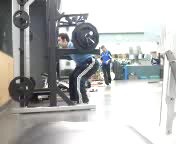Understanding posture: it's more than just standing up straight !
 |
 |
The idea of posture inclines most people to think of the position of the shoulders and head while upright. Postural integrity/alignment, however, takes different forms during different positions and actions. Understanding how postural needs change depending on function and position is important for optimizing posture in various situations.
So aside from standing up straight, what does good alignment entail? Well good postural status involves muscles effectively assuming/maintaining sound joint positions despite oppositional forces. Such forces can be in the form gravity alone, gravity plus inertia, as well as the aforementioned plus load as when weight training.
Regardless of the nature of the forces oppositional to good alignm ent, however, effective resistance to those forces is critical. In many instances, preemptive assumption of joint-positions/postures oppositional to impending forces is good practice. As such, knowledge of how peeemptively assume oppositional joint positions is of great importance.
Now because there are more joints in the body and threatening situations than that which can be covered here, discussion is limited to common joints vulnerable to injury during exercise. Among the joints vulnerable during exercise situations include the neck, shoulders, wrists, low-back and knees. Many common exercise situations present conflicting forces to the sound alignment of these joints.
The Neck
Many exercise situations challenge sound neck position and, considering neck position impacts whole-spine position, neck posture is critical to whole body position. Fortunately, however, the preemptive strategy for proper neck position is usually the same in most situations. The neck alignment to assume before engaging in an exercise that might challenge it, involves maneuvering the neck in the direction opposite to that which gravity wants to pull it. For example, in a squat, gravity will pull the neck downward so prepare by lifting the head upward; whereas the opposite is true during a sit-up.
The Shoulders
As is the case with the neck, preemptive shoulder position should be oppositional to the forces acting on them. In many cases though, multiple forces in multiple directions are challenging sound shoulder alignment. As such, it's important to remember that it's not always gravitational force that you're trying to oppose. Take a bench-press, for example, gravity wants to pull your shoulders down but the force most threatening to shoulder posture is that of the pecs; pec force can pull the shoulders into a weak rounded position so, in this case holding the shoulder-blades tightly back with gravity is advised.
The Low-Back
During many exercises, the the lumbar curve of the low-back is subjected to oppositional forces. Such forces often force the low-back into positions of lesser integrity. Often times these vulnerable positions entail flexion and/or hyperextension at inopportune times. Inopportune flexion often occurs during during squats and deadlifts due to load pulling the spine into flexion and/or the hip extensors posteriorly tilting the pelvis. Dysfunctional hyperextension occurs during many exercises, however quite notoriously during overhead pressing where hyperextension is an attempt at standing bench-presses.
To minimize inopportune flexion/hyperextension, position the low-back in the antithesis position to that of impending forces. To offset inopportune flexion, preemptively assume the antithesis position of hyperextension before loading. Same goes for the offset of hyperextension; tighten the abs and glutes to lock the pevis.
The Wrists
Faulty wrist position occurs commonly during presses and curls. The direction of force during presses and curls can hyperextend the wrists; which, over time, can lead to conditions like carpal tunnel syndrome. Luckily however, there are a few ways to disincline wrist hypertension. The most accessible way to ensure sound wrists during challenging exercises is to squeeze the the handle/s you're grasping. In addition to stabilizing the wrists,squeezing amplifies the force exerted against the resistance. Though not as accessible, additional ways to stabilize the wrists include using thicker bars and/or multi-grip bars which forces a squeeze grip.
The Knees
Everyone who's performed squatting movements with any regularity has felt knee discomfort. Such discomfort is likely due to poor knee posture. During squatting movements, improper knee position often involves the shins being out of line with the direction of resistance. Such mal-alignment usually takes the form of the knees buckling inward and/or passing beyond the toe. The more frequently the knees are stressed in these deviated positions, the likelier pain and injury will result.
To discourage the knees from venturing into common vulnerable positions, adjust where on the foot you exert pressure. Because the most common deviations of the knee are inward buckling and passing beyond the toe, adjust foot pressure to the heels and outer foot. Exerting pressure though the heels and outer foot encourage a knee position in which the shins are behind the toes and knees tracking outward. This shins behind toes/knees out position is the antithesis of the most common deviations of the knee. Such a position, therefore, should guard against irritating/vulnerable knee positions.
Take this home
Posture is about positioning the joints of the body in a position of best integrity relative to the demands encountered. During weight training, postural awareness should prioritize the joints most vulnerable during said exercise. Example joints inclined toward vulnerable posture during weight training include the neck, shoulder, low back, wrists and knees. Contemplating and preparing the joints to resist oppositional forces can help guard against venturing into such vulnerable positions.